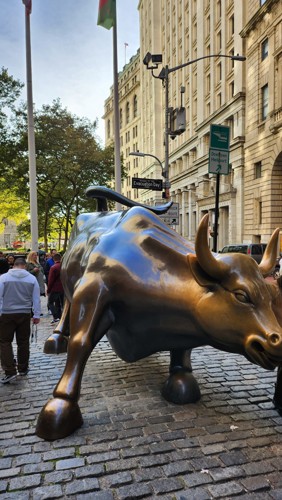With international travel back on the agenda, it was great to get the opportunity to head over to the US recently for a research trip and meet a swathe of likeminded investors. Notwithstanding the harshness of the drawdowns endured across share and bond markets, the excitement amongst these investment professionals was palpable, as pockets of extreme dislocations in markets has exposed fertile hunting ground for future outperformance.
As asset allocators, the frustrations associated with investing in a market where traditional asset classes have sold-off in a correlated fashion was shared amongst everyone I met on the trip. However, the unambiguous takeaway was that the best returns always follow a bout of indiscriminate selling, and that patience is a virtue in these conditions.
Investors’ North Star
The most common thematic which presented across virtually every meeting was the increasing importance of environmental, social and governance (ESG) integration when analysing investments. Across the 15 fund manager meetings that I attended, typically a session would be reserved to meet their dedicated ESG analysts to showcase the advancements they’ve achieved in this space.
Where views markedly differed was on the degree that ESG considerations should feature in portfolio construction. These factors existed on a spectrum, spanning from pure risk mitigation to ‘impact’ investing, whereby measurable social and environmental outcomes were prioritised alongside a financial return.
Interestingly, there was a common acknowledgement that Responsible Investing (RI) needed to evolve as the war in Ukraine had opened a chasm in how RI is perceived. Where previously the most strident supporters of exclusion-based investing (i.e. fossil fuels) had advocated for a radical idealistic approach, in many instances this had been replaced with a more pragmatic and realistic attitude. This spanned a transition period for fossil fuel investing to a relaxation around weapons and armaments exclusions (provided they’re being used to protect democracies).
Overall, there was an ongoing emphasis around engaging rather than excluding, which will invariably require a balanced understanding from investors, which will take time.
For our Responsible Investment portfolios, these meetings reaffirmed our nuanced portfolio construction methodology which offers dynamism and a willingness to allocate to managers’ explicitly targeting companies improving their ‘green’ credentials – as opposed to basic exclusions.

The ‘hustle and bustle’ synonymous with New York
Inflation elation
After a torrid year of persistently higher inflation prints, it was refreshing to hear some optimism that inflation in the US had likely peaked. Upon returning home, this view was subsequently confirmed (at least in the short term), by the US inflation numbers finally surprising to the downside at an annual headline rate of 7.7%. Despite remaining uncomfortably high, this was all the encouragement that the tech-heavy Nasdaq needed to soar 7.4% in one day.
Amongst the varied discussions that I had with different portfolio managers around inflation and fixed income markets, the common thread revolved around adding duration – or interest rate sensitivity - back into portfolios.
As a refresher, an improved global economic backdrop over the last 12-months has produced a powerful rise in inflation. Consequently, central banks have responded through aggressively increasing interest rates to choke-off demand within the economy, which flows through to higher bond yields.
Higher bond yields translate to higher interest rates, which has a contractionary effect due to higher borrowing costs for individuals, governments and businesses which then discourages investment and spending. And due to the inverse relationship shared between yields and the capital value of bonds, this has prompted bonds to reprice heftily lower.

Make hay while the sun shines - or not if it's snowing in Denver!
How low can you go?
Fortunately, our portfolios have been intentionally positioned with lower duration (less interest rate sensitivity) than the benchmark, resulting in a more subdued pullback for our investors’ fixed income allocations. We’re now actively assessing whether we moderate this positioning in light of the newly attractive bond yields available.
The washout in fixed income markets, whilst painful, has led to a lot of the normalisation expected to unfold over a longer period. This has dramatically reinvigorated the defensive qualities associated with fixed income due to the higher starting yields, which makes the asset class significantly more appealing for us. Furthermore, should we enter a recession where interest rates are cut, having more interest rate sensitivity means that the value of our bonds will rise and the negative correlation between bonds and shares should reassert itself.
Opening Pandora’s Box
A highly contentious topic which continually reappeared was the outlook for private assets, given investors’ erroneous perception that they offer greater safety versus their publicly listed counterparts. This misperception stems from the reduced volatility associated with private assets due to their illiquidity.
The primary difference comes down to how the two are traded, with publicly listed securities offering liquidity on a public exchange (i.e ASX200) whereas private assets are exchanged infrequently between two or more private counterparties. This is particularly topical given the scrutiny around the performance profile of our local industry super funds, with question marks around the lack of write-downs to date on their private assets.
Naturally, there was no consensus on whether the private market values would catch-down to their listed market equivalents, or whether their run of outperformance would be sustained. However, in-line with our views was the increasing importance of ‘alternatives’ in portfolio construction to deliver uncorrelated and differentiated return streams to buffer the broader market volatility.
So bearish it’s bullish
With investor sentiment exceptionally depressed and markets heavily oversold, it typically doesn’t take much for a strong reversal to take hold. We’ve seen this more recently with markets intent on buying any suggestion that inflation has peaked and that the path of interest rate hikes will moderate.
Importantly, with markets materially disconnected from their underlying fundamentals, this will present opportunities, yet past lessons demonstrate that you need to be careful not to jump in too soon. And despite the lingering uncertainty around inflation, interest rates and earnings, we believe a more constructive baseline for markets awaits as we enter a new year.

The 'Charging Bull' of Wall Street providing some overdue optimism




